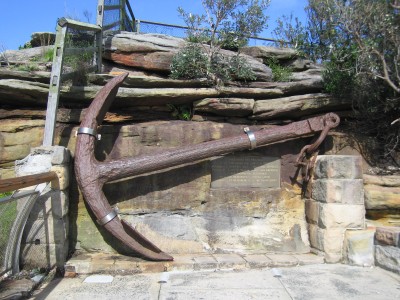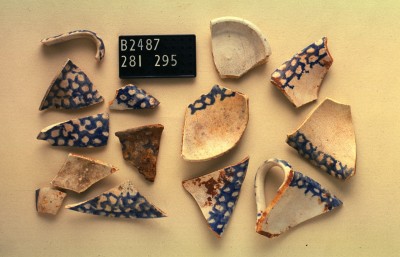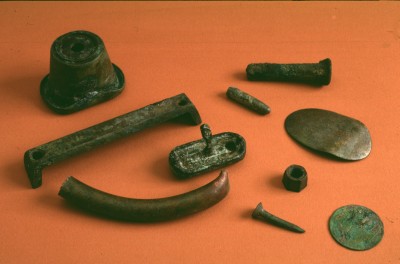Era: 1840 - 1900 Cultural background: English Collection: Powerhouse Museum Theme:Boats Government Settlement Ship Wrecks

The Admiralty Anchor recovered from the Dunbar wreck site in 1910 and later displayed at The Gap at Watsons Bay as a permanent memorial to those lost in the tragedy. Photograph Stephen Thompson.
Collection
Powerhouse Museum, Sydney, Australia.
Object Name
Dunbar shipwreck collection.
Object/Collection Description
Archaeological material removed or excavated form the immigrant ship Dunbar that was wrecked off the south head of Port Jackson in 1857. The collection consists of anchors, bottles, coins, buttons, spectacles, a telescope, sextant and cannon.
 Dunbar, David Little, 1900. Courtesy State Library of Victoria
Dunbar, David Little, 1900. Courtesy State Library of VictoriaThe Dunbar was wrecked during a period of great social and economic growth in Australia. The Australian gold rushes of the early 1850s had created increased demand for imports and emigrants. This demand also boosted New South Wales agriculture, industry and commerce. Transportation and trade was dominated by British shipping. However, British ship design was seriously challenged by the introduction fast American clippers. The 1850s saw marked design innovations including the development of faster ships like the Dunbar.
 Wreck of the Dunbar, South Head, Dr Doyle’s sketch book / John Thomas Doyle & Samuel Thomas Gill, c.1862-1863. Courtesy Mitchell Library, State Library of New South Wales
Wreck of the Dunbar, South Head, Dr Doyle’s sketch book / John Thomas Doyle & Samuel Thomas Gill, c.1862-1863. Courtesy Mitchell Library, State Library of New South WalesThe Australian gold fields’ demand for passenger ships led shipowners such as Duncan Dunbar to order the construction of a clipper from the English shipbuilding firm of James Laing and Sons at Sunderland in 1852.
Named after its wealthy owner, the Dunbar took more than sixteen months to build at a cost of over £30 000. When launched in 1853, the Dunbar was the largest vessel ever built at Sunderland. With a hull and frames of British oak and deck of East India teak, the Dunbar was a first class ship. It had a British lion figurehead, characteristic of a Dunbar ship. Because of the Crimean War, the Dunbar‘s initial use was as a troop ship. It was not until 1856 that the first visit was made to Australia. On arrival in Port Jackson, the Sydney Morning Herald flourished that ‘the Dunbar is a splendid vessel”. The Dunbar remained in Sydney for three months, returning to England that same year. By May 1857, the vessel and crew were ready for a second voyage to the colony.
 Belt Buckle, Battle of Alma, 1854 -1857, excavated from the wreck of the Dunbar. Courtesy Powerhouse Museum
Belt Buckle, Battle of Alma, 1854 -1857, excavated from the wreck of the Dunbar. Courtesy Powerhouse MuseumOn the return voyage, the Dunbar arrived off Sydney Heads on the night of Thursday, 20 August 1857 in appalling conditions. Heavy rain and squalls reduced visibility to a few hundred metres, obscuring the sandstone cliffs at the entrance to Port Jackson. Captain Green had made a number of visits to Port Jackson and had been captain on the Dunbar on its 1856 voyage. On the approach to Port Jackson in 1857 Green misjudged the ship’s position in relation to the heads because of the poor visibility. On the turn for the run into port he believed that they were approaching North Head. When the shout ‘breakers ahead!’ was heard, Captain Green, still believing their position to be north of the harbour entrance, ordered ‘hard-a-port’. Instead of entering the safety of the harbour, the Dunbar crashed onto boulders at the foot of South Head.
The impact brought down the masts, huge waves sank the lifeboats and the Dunbar heaved broadside in the swell. Lying on side on to the cliffs, the vessel broke up almost immediately. One man, able seaman James Johnson, was washed onto a ledge on the cliff face was the only survivor. The remaining 58 crew and all 63 passengers drowned. Dawn that morning unveiled a grave tragedy for the community of the small Georgian town of Sydney. The death toll of 121 lives staggered the population. Thousands of onlookers travelled to the scene and the unwanted task of identifying relatives, friends and business associates soon began. James Johnson clung to his precarious spot on the rock ledge until the morning of the 22 when he was noticed from the cliff top. The victims of the Dunbar were buried at St Stephens Church, Newtown.
The Dunbar Collection is historically significant as evidence of the loss of the Dunbar at sea, the tragic loss of life and the evolution of sea safety in New South Wales. The dramatic loss of the fine immigrant ship and that of the Catherine Adamson shortly afterwards, created enormous political pressure for the locating of a lighthouse closer to South Head (Hornby Light) than the existing lighthouse (Macquarie Light).
 Grave of Dunbar victims at St Stephens Church, Newtown, c.1900. Courtesy Mitchell Library, State Library of New South Wales
Grave of Dunbar victims at St Stephens Church, Newtown, c.1900. Courtesy Mitchell Library, State Library of New South WalesThe Dunbar Collection represents the dangers associated with immigrant travel in the 19th century. The events that followed the wreck, the search, the recovery, the inquiry and burial of the victims, had a considerable impact on the colony. The population of New South Wales still consisted of a significant proportion of people who had travelled by sea and who were able to directly relate to its hardships and dangers. The Sinking of the Dunbar is an event that had considerable impact on colonial society in Australia and which contributed to the improvement of navigation facilities in Port Jackson.
The Dunbar Collection has intangible significance through its continuing association with descendants of the victims and as one of the most well known Australian maritime tragedies. The social value of the shipwreck is demonstrated by the continuing memorial services held at St Stephens church, Newtown and by the thousands of visitors who view the memorial plaques at the cliff top above the wreck site.
The Dunbar Collection is extremely rare as it is associated with a specific event, vessel and a shipwreck associated with a large loss of life in close proximity to a major port and centre of population.
The Dunbar Collection is overall in a good condition.
The Dunbar Collection is associated with a notorious shipwreck and has interpretative potential to mediate the dangers associated with immigrant travel in the 1850s.
Bibliography
Foley, J D 1995, In Quarantine, Kangaroo Press, Sydney.
Nutley, D & Smith, T 1992, Dunbar 1854 – 1857 Conservation Management Plan, NSW Heritage Office.
Heritage Office & Dept of Urban Affairs & Planning 1996, Regional Histories of NSW, Sydney.
Heritage Collections Council 2001, Significance: A guide to assessing the significance of cultural heritage objects and collections, Canberra.
Websites
www.heritage.nsw.gov.au/07_subnav_02_2.cfm?itemid=5001064
www.anmm.gov.au/site/page.cfm?u=1478
Migration Heritage Centre.
September 2006 – updated 2011Crown copyright 2006©
The Migration Heritage Centre at the Powerhouse Museum is a NSW Government initiative supported by the Community Relations Commission.
www.migrationheritage.nsw.gov.au
Regional Services at the Powerhouse Museum is supported by Movable Heritage, NSW funding from the NSW Ministry for the Arts.





